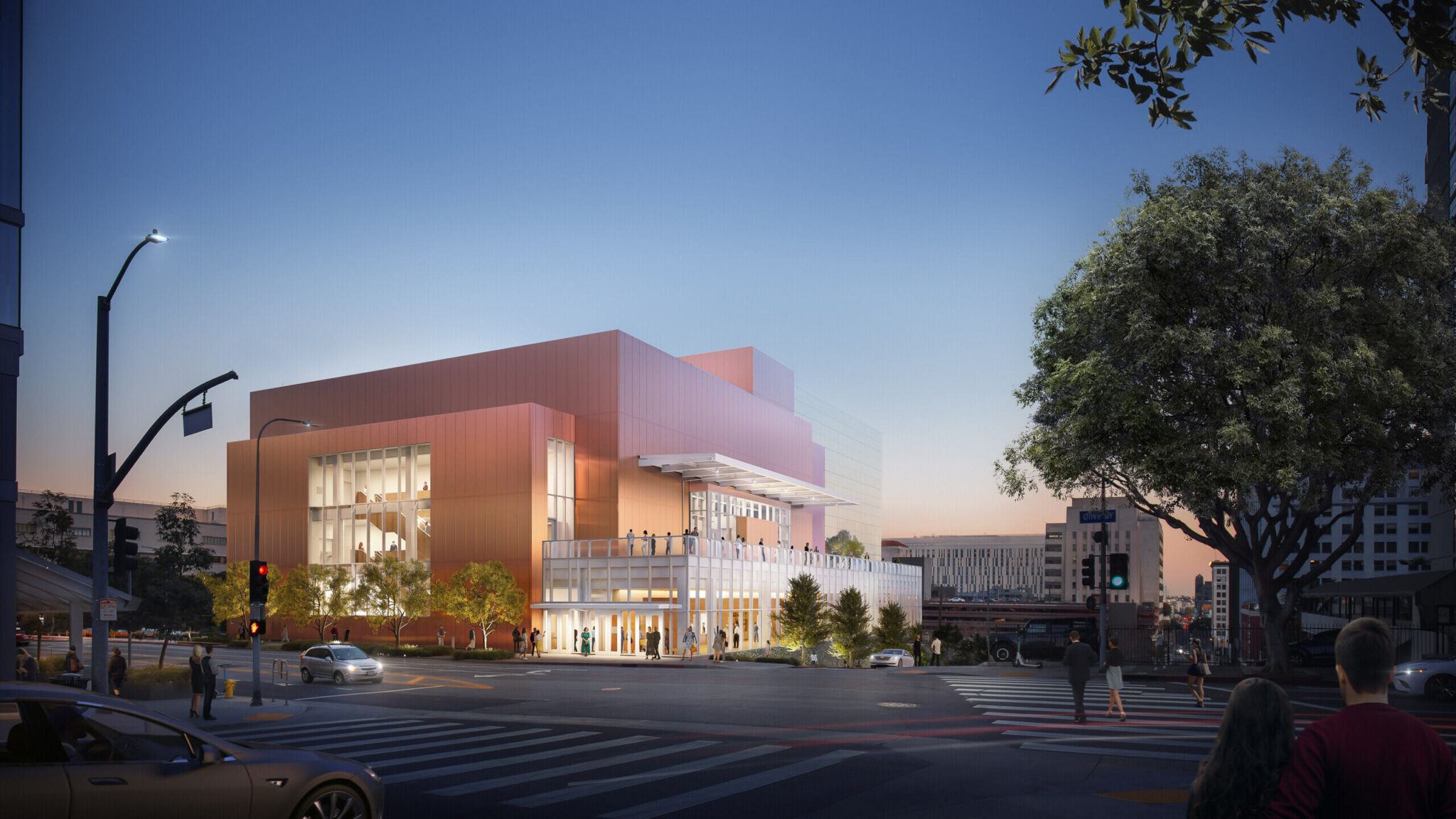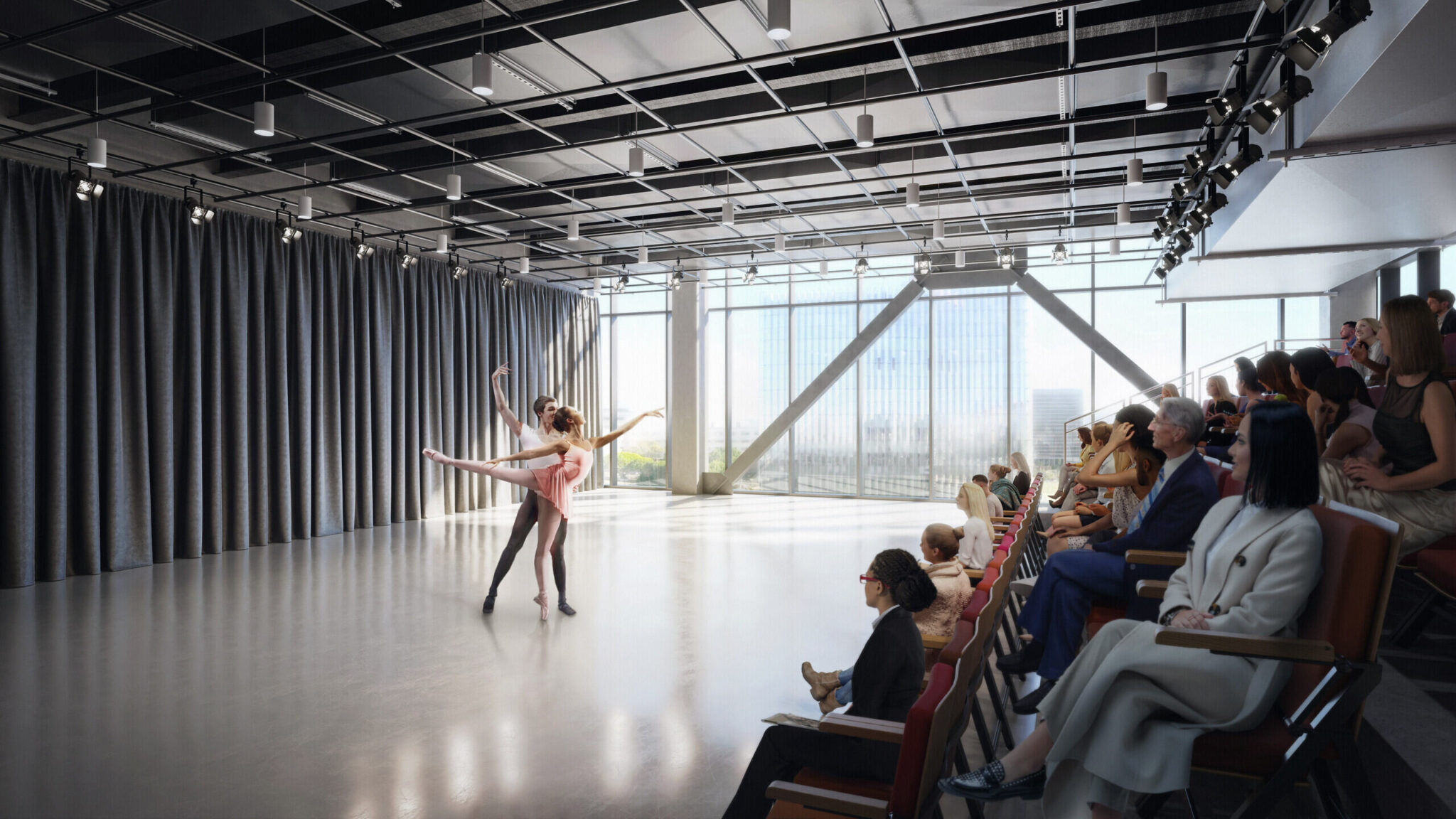In April, the Colburn School, an institute for music and dance education and performance, will break ground on a 100,000-sf expansion designed by architect Frank Gehry. Located in downtown Los Angeles, the performing arts center will join the neighboring Walt Disney Concert Hall and The Grand by Gehry, forming the largest concentration of Gehry-designed buildings in the world.
“This has been a long time in the making. The Colburn School expansion is a much-needed project for the community,” famed architect Frank Gehry said in a press statement. “I hope that it will be well-used and well-loved by the students of the Colburn School and the other cultural institutions of Los Angeles.”
The Colburn School provides music and dance education at all levels of development, from children as young as 7 months old to adults. Each week, the downtown L.A. campus welcomes about 10,000 people, and each year, over 2,000 students from around the world study at Colburn.
The new building, the Colburn Center, will be adjacent to Colburn’s Grand Avenue campus. In addition to training and performance facilities for music and dance, the Colburn Center will provide a concert hall for the region’s performing arts organizations—downtown L.A.’s first midsized concert hall, according to the Colburn School. The 1,000-seat, 17,200-sf hall will feature an in-the-round design, an orchestra pit, and a stage that can accommodate large-scale works.
Frank Gehry hopes to strengthen L.A.’s classical music community
“Our goal for this hall is that it will help strengthen the already robust classical music community here, solidifying Los Angeles’ leadership in this arena,” Gehry said.
The Colburn Center will more than double the facilities for the school’s Trudl Zipper Dance Institute, including a 100-seat theater for dance and four professional-sized studios for dance instruction and rehearsal.
The building’s new rooftop garden will be large enough for receptions and outdoor performances, while a ground-level garden will have a performance space that will be open to the public.
According to the press statement, Gehry’s design is “conceived as an ensemble of interlocking volumes, each of which houses a distinct program while interacting dynamically with the whole, the new Colburn Center will be built into a terrain that slopes down from Olive Street to Hill Street and clad in a pink metallic finish. The components are knit together by an expansive light-filled entrance and a pair of gardens planted at street and rooftop level.”
To date, gifts to the Colburn School total about $315 million toward its $400 million Building Our Future campaign. The campaign will cover about $335 million in construction costs and $65 million in endowment and operating costs for the Colburn Center and the Colburn School.
The performing arts center is expected to reach substantial completion in early 2027.
On the Building Team:
Owner: The Colburn School
Architect: Gehry Partners
Civil engineer: KPFF
MEP engineer: ARC Engineering
Structural engineer: Magnusson Klemencic Associates
Contractor: McCarthy







Related Stories
| Jun 12, 2014
Austrian university develops 'inflatable' concrete dome method
Constructing a concrete dome is a costly process, but this may change soon. A team from the Vienna University of Technology has developed a method that allows concrete domes to form with the use of air and steel cables instead of expensive, timber supporting structures.
| Jun 9, 2014
Green Building Initiative launches Green Globes for Sustainable Interiors program
The new program focuses exclusively on the sustainable design and construction of interior spaces in nonresidential buildings and can be pursued by both building owners and individual lessees of commercial spaces.
| May 29, 2014
7 cost-effective ways to make U.S. infrastructure more resilient
Moving critical elements to higher ground and designing for longer lifespans are just some of the ways cities and governments can make infrastructure more resilient to natural disasters and climate change, writes Richard Cavallaro, President of Skanska USA Civil.
| May 20, 2014
Kinetic Architecture: New book explores innovations in active façades
The book, co-authored by Arup's Russell Fortmeyer, illustrates the various ways architects, consultants, and engineers approach energy and comfort by manipulating air, water, and light through the layers of passive and active building envelope systems.
| May 19, 2014
What can architects learn from nature’s 3.8 billion years of experience?
In a new report, HOK and Biomimicry 3.8 partnered to study how lessons from the temperate broadleaf forest biome, which houses many of the world’s largest population centers, can inform the design of the built environment.
| May 13, 2014
19 industry groups team to promote resilient planning and building materials
The industry associations, with more than 700,000 members generating almost $1 trillion in GDP, have issued a joint statement on resilience, pushing design and building solutions for disaster mitigation.
| May 11, 2014
Final call for entries: 2014 Giants 300 survey
BD+C's 2014 Giants 300 survey forms are due Wednesday, May 21. Survey results will be published in our July 2014 issue. The annual Giants 300 Report ranks the top AEC firms in commercial construction, by revenue.
| May 2, 2014
World's largest outdoor chandelier tops reworked streetscape for Cleveland's PlayhouseSquare
Streetscape project includes monumental gateway portals, LED signage, and a new plaza, fire pit, sidewalk café, and alfresco dining area.
| Apr 29, 2014
USGBC launches real-time green building data dashboard
The online data visualization resource highlights green building data for each state and Washington, D.C.
| Apr 16, 2014
Upgrading windows: repair, refurbish, or retrofit [AIA course]
Building Teams must focus on a number of key decisions in order to arrive at the optimal solution: repair the windows in place, remove and refurbish them, or opt for full replacement.
















